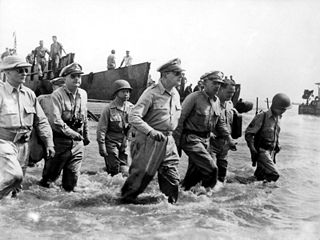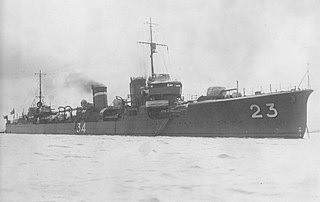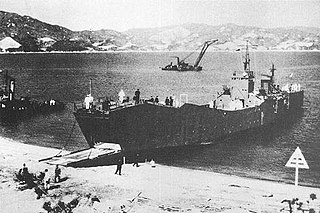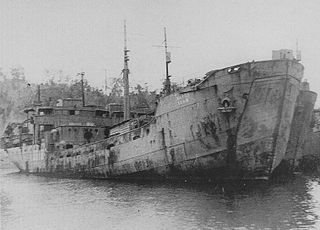
The Battle of Leyte in the Pacific campaign of World War II was the amphibious invasion of the island of Leyte in the Philippines by American forces and Filipino guerrillas under the overall command of General Douglas MacArthur, who fought against the Imperial Japanese Army in the Philippines led by General Tomoyuki Yamashita. The operation, codenamed King Two, launched the Philippines campaign of 1944–45 for the recapture and liberation of the entire Philippine Archipelago and to end almost three years of Japanese occupation.

The Battle of Ormoc Bay was a series of air-sea battles between Imperial Japan and the United States in the Camotes Sea in the Philippines from 11 November-21 December 1944, part of the Battle of Leyte in the Pacific campaign of World War II. The battles resulted from Japanese operations to reinforce and resupply their forces on Leyte and U.S. attempts to interdict them.

Uranami was the tenth of twenty-four Fubuki-class destroyers, built for the Imperial Japanese Navy following World War I. When introduced into service, these ships were the most powerful destroyers in the world. They served as first-line destroyers through the 1930s, and remained formidable weapons systems well into the Pacific War.

Hatsuharu, the second Imperial Japanese Navy destroyer of the name, was the lead ship of six Hatsuharu-class destroyers built under the Circle One Program. Three were laid down in JFY 1931 and the next three in JFY 1933. The remaining six ships in the plan were built as the Shiratsuyu class.

Shimakaze (島風)(Island Wind) was an experimental destroyer of the Imperial Japanese Navy during World War II, and intended as the lead ship in a projected new "Type C" of destroyers. She was the only destroyer to be armed with 15 torpedo tubes, each capable of firing the deadly 610 mm (24 in) Type 93 "Long Lance" torpedo. The ship also served as a testbed for an enormously powerful, high-temperature, high-pressure steam turbine that was able to develop 79,240 shp (59,090 kW). This made her one of the fastest destroyers in the world: her design speed was 39 kn, but on trials she made 40.9 kn.

Kiso (木曾) was the fifth and last of the five Kuma-class light cruisers, which served with the Imperial Japanese Navy during World War II. She was named after the Kiso River in central Honshū, Japan.

Uzuki was one of twelve Mutsuki-class destroyers built for the Imperial Japanese Navy (IJN) during the 1920s. During the Pacific War, she participated in the Battle of Wake Island in December 1941 and the occupations of New Guinea and the Solomon Islands in early 1942.

The Japanese destroyer Yūzuki was the last of twelve Mutsuki-class destroyers built for the Imperial Japanese Navy (IJN) during the 1920s. During the Pacific War, she participated in the Battle of Guam in December 1941 and the occupations of New Guinea and the Solomon Islands in early 1942.

The No.101-class landing ships were a class of amphibious assault ships of the Imperial Japanese Navy (IJN) and Imperial Japanese Army (IJA), serving during and after World War II. The No.101 class ships were powered by diesel engines, while the similar No.103-class landing ships were powered by a steam turbine engine. The IJN called them 2nd class transporter. The No.103 class included the IJA's SB craft variant. This article handles them collectively.

The SS-class landing ship was a class of amphibious assault ships of the Imperial Japanese Army which served during World War II. The SS meaning are Sensha-Small.
The SS China Maru was a 5,870-gross register ton cargo ship built by Kawasaki Dockyard Company, Kobe, for Kawasaki Kisen Kabushiki Kaisha in 1920.

CD-17 was a C Type class escort ship (Kaibōkan) of the Imperial Japanese Navy during the Second World War.
CD-19 was a C Type class escort ship (Kaibōkan) of the Imperial Japanese Navy during the Second World War.
CH-17 was a No.13-class submarine chaser of the Imperial Japanese Navy during World War II.
W-101 or No. 101 was a Bangor-class minesweeper that was seized by the Imperial Japanese Navy before completion during World War II and converted into a convoy escort.
Patrol Boat No. 105 (第百五號) (ex-Arayat) was a former Philippine Commonwealth customs inspection and enforcement cutter that was sunk by the Japanese during the invasion of the Philippines and later raised and designated as a patrol boat in the Imperial Japanese Navy.
Cha-216 or No. 216 was a No.1-class auxiliary submarine chaser of the Imperial Japanese Navy that served during World War II.










